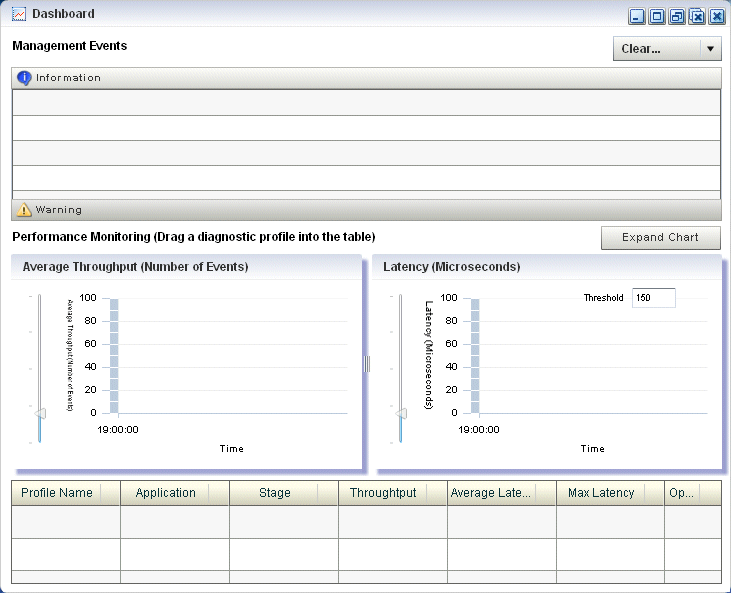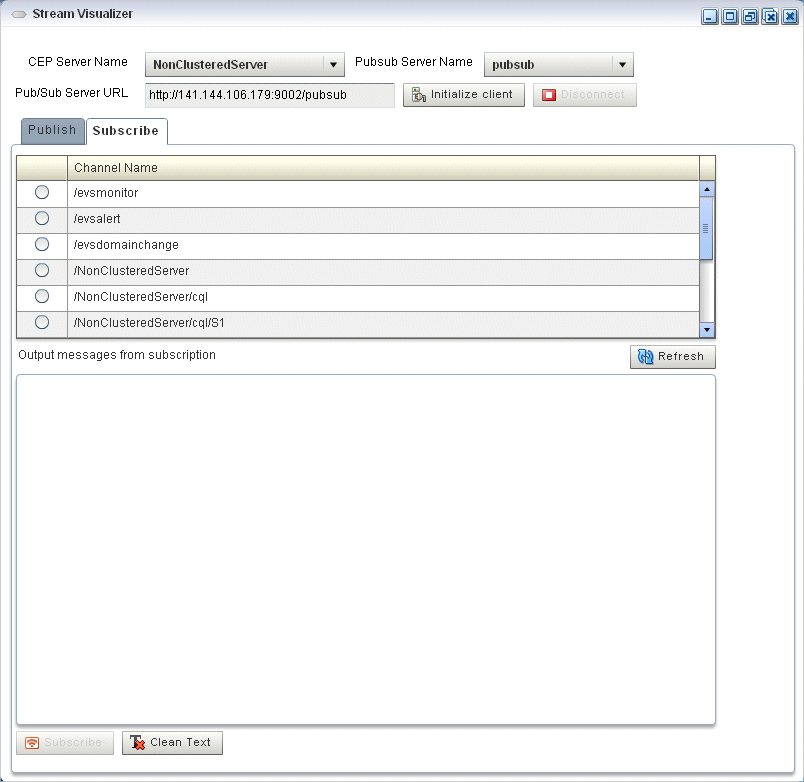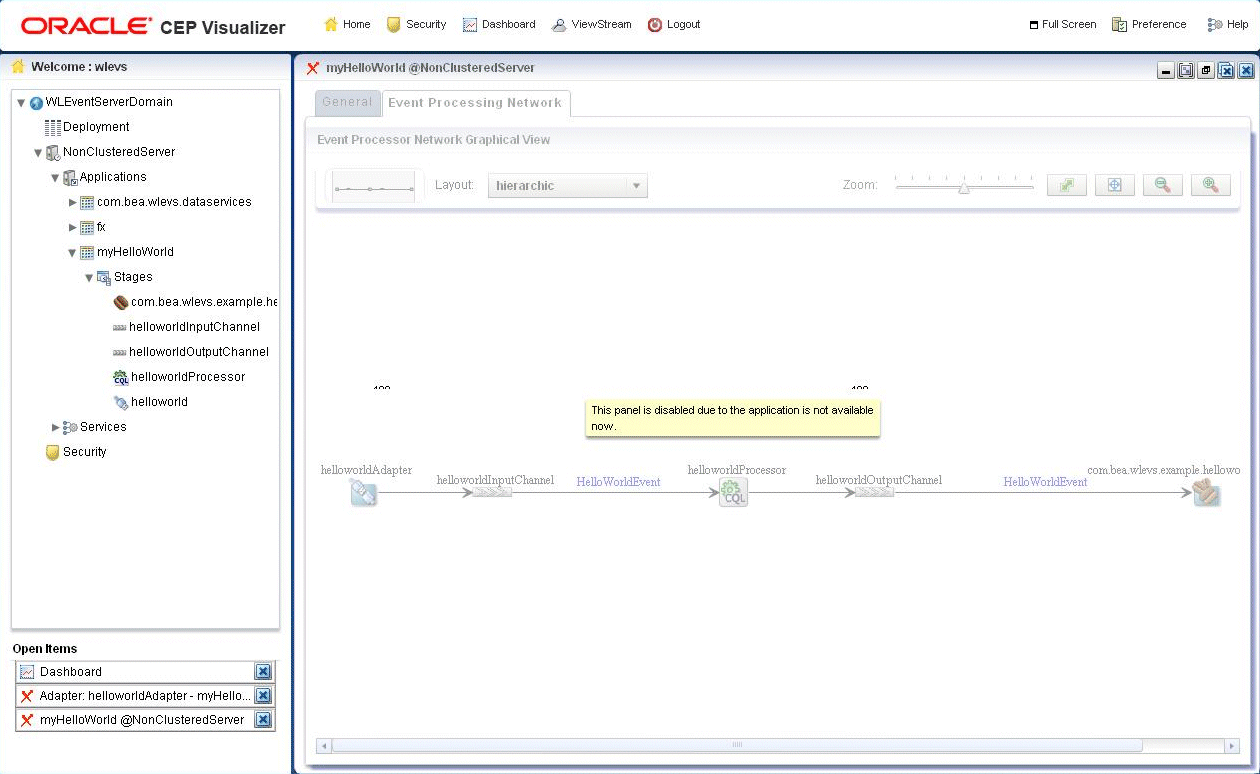1 Oracle Event Processing Visualizer
Oracle Event Processing Visualizer is a browser-based tool that enables you to view, develop, configure, and monitor aspects of Oracle Event Processing applications. You can also administer the Oracle Event Processing servers and domains.
This chapter includes the following sections:
1.1 Use Visualizer to Perform Tasks
You can use Visualizer to perform the following tasks:
-
View the structure of an Oracle Event Processing domain
-
Manage security
-
Configure Oracle Event Processing server instances
-
Install, uninstall, suspend, resume, and update applications
-
View, update, create, and delete Oracle CQL rules
-
View the EPN associated with an application
-
Tune application parameters and monitor application status
-
Record and playback of events flowing through the EPN.
-
Create diagnostic profile to monitor application stage latency and throughput.
-
Monitor and perform diagnosis on your CQL Processor with Query Plan.
-
Manage and create server-wide resources such as HTTP publish-subscribe channels and data sources.
-
Dynamically turn server and application logging on and off.
-
Manage Oracle Coherence cluster and server instances.
1.2 Visualizer User Interface
As Figure 1-1 shows, the Oracle Event Processing Visualizer has the following main panes:
Figure 1-1 Sample Oracle Event Processing Visualizer Window

Description of "Figure 1-1 Sample Oracle Event Processing Visualizer Window"
Figure 1-1 shows a domain that contains a single server instance called NonClusteredServer. The server contains four deployed applications: com.bea.wlevs.dataservices, cql, fx, and signalgeneration; the cql application is currently opened. The right pane contains the dashboard. The application called com.bea.wlevs.dataservices is associated with Oracle Event Processing Visualizer itself and is always deployed in an Oracle Event Processing server instance. Manage Applications for details.
1.2.1 Top Pane
This pane includes the most used buttons:
-
Home button that takes you to the main Oracle Event Processing Visualizer page.
-
Security button that takes you to the security page in which you can add or configure users and groups and map users to application roles and task roles; see Security Tasks for details.
-
Dashboard button takes you to the performance management screen that you use to monitor the throughput and latency of a running application and its stages; see Visualizer Dashboard for more information.
-
ViewStream button takes you to a screen from which you can monitor the messages streaming through the configured HTTP publish-subscribe channels; see Stream Visualizer (ViewStream) Panel for more information.
-
Full Screen button fills your entire computer screen with the Oracle Event Processing Visualizer tool; press the Esc key to return to a normal screen.
-
Preferences button takes you to a page where you can set user preferences, such as the language and maximum number of open panes, and accessibility settings such as restricting the maximum number of open panes to 1 and disabling Full Screen mode.
-
Help button takes you to the task-oriented online-help hosted by the Oracle Event Processing server.
1.2.2 Left Pane
This pane displays a domain tree for the domain that includes all the objects contained in the domain, such as the Oracle Event Processing server instances, the deployed applications and services within each server instance, and domain-level security configuration.
The domain name is determined by the Oracle Event Processing server config.xml file domain element. For example, the domain tree is named mydomain if your config.xml file is like this:
<domain>
<name>mydomain</name>
</domain>
The Open Items box in the lower half of the left pane lists the items that are currently open, making it easy to return to or close the windows after you have navigated away from them. Any open panels that require refresh are marked with a red X in the Open Items list. For more information, see Panels that Require Refresh .
1.2.3 Right Pane
This pane is a multi-document container. When you open multiple documents, the documents are overlaid one on top of the other.
This pane displays information about objects that you have clicked on in the left pane. The format of the information depends on the object; for example, if you click on a deployed application in the domain tree in the left pane, the right pane shows general information about the application (General tab) as well as various visual representations of the event processing network of the application (Event Processing Network tab). If you click on a particular stage of the network, such as a stream or processor, the right pane shows general information about it as well as stage-specific information, such as the rules for a processor. For more information, see Event Processing Network.
Any open panels that require refresh are marked with a red X in the title of the panel. For more information, see Panels that Require Refresh.
Table 1-1 describes the buttons in the top right corner of the right pane that you can use to manage panels. Note that these buttons are not visible if you set the Max Open Panels preference to 1 (see Manage User Preferences).
Table 1-1 Panel Controls
| Button | Description |
|---|---|
|
|
Minimize panel. |
|
|
Maximize panel to full window size. |
|
|
Maximize panel. |
|
|
Close all panels. |
|
|
Close panel. |
1.2.4 Visualizer Dashboard
Figure 1-2 shows the Oracle Event Processing Visualizer dashboard: a performance management screen that you use to monitor the throughput and latency of a running application and its stages or a path between two stages. You get to the dashboard by clicking the Dashboard button in the top pane.
Figure 1-2 Oracle Event Processing Visualizer Dashboard

Description of "Figure 1-2 Oracle Event Processing Visualizer Dashboard"
The dashboard has two main sections:
-
Management Events: the section at the top of the dashboard displays information and warning messages about the incoming monitoring events. Click the Warning bar to view the list of warning messages; click the Information bar to view the list of information messages.
-
Performance Monitoring: the latency and throughput graphs display the amount of time it takes an event to pass through the specified stage or path in the EPN or the number of events passing through, respectively. The stage or path is defined in the diagnostic profile. The table at the bottom lists the available diagnostic profiles; when you click on a particular profile, the corresponding latency and throughput information is displayed in the graphs. See Monitor the Throughput and Latency of an EPN Stage or Path for details.
For detailed instructions on how to use this monitoring feature, see Monitor the Throughput and Latency of an EPN Stage or Path.
1.2.5 Stream Visualizer (ViewStream) Panel
The main purpose of the ViewStream panel is to allow users to watch events being published to a given HTTP publish-subscribe channel without any additional work. This is useful for debugging your application or just monitoring events flowing through the EPN.
Click the ViewStream button in the top panel of Oracle Event Processing Visualizer, to display the Stream Visualizer panel as Figure 1-3 shows.
Figure 1-3 Oracle Event Processing Visualizer Stream Visualizer (ViewStream)

Description of "Figure 1-3 Oracle Event Processing Visualizer Stream Visualizer (ViewStream)"
The Pub/Sub Server URL text box displays the HTTP pub-sub server URL included with Oracle Event Processing. Click the Initialize Client button to start the process. You can either subscribe or publish a message to a channel using the options mentioned in this panel.
You can subscribe to a user or internal channel and view the events on it or you can publish to a user or internal channel.
For more information, see:
1.2.6 Event Processing Network
The main purpose of the Event Processing Network (EPN) panel is to give users an overall view of the stages in an Oracle Event Processing application and the various event types they produce and consume.
In the left pane, navigate to and expand the Applications node, select an application, and in the right pane, click the Event Processing Network tab to view the EPN as Figure 1-4 shows.
Figure 1-4 Event Processing Network Panel

Description of "Figure 1-4 Event Processing Network Panel"
1.2.7 Event Processing Network Context Menu
You can right-click any stage in the Event Processing Network and select one of the options from the Event Processing Network context menu that Table 1-2 describes.
|
Table 1-2 Event Processing Network Context Menu
|
1.2.8 Panels that Require Refresh
Some operations, such as uninstalling and redeploying an application, will require you to refresh open panels.
When Oracle Event Processing Visualizer receives a notification for application re-deployment, it goes though all the affected panels that are still opened and marks the title of the panel with a red X to indicate that this panel is obsolete. To refresh such a panel, close and then re-open the panel.
For example, Figure 1-5 shows the Event Processing Network tab for an application that has been redeployed.
Figure 1-5 Event Processing Network Tab - Requiring Refresh

Description of "Figure 1-5 Event Processing Network Tab - Requiring Refresh"
1.3 Administration Tasks
This section describes the principle administration tasks you can perform using the Oracle Event Processing Visualizer, including:
1.3.1 Manage Applications
Using Oracle Event Processing Visualizer, you can monitor and configure applications you develop and deploy as well as applications that Oracle Event Processing server deploys such as the com.bea.wlevs.dataservices application. You can monitor and configure the Event Processing Network (EPN), application lifecycle, and Oracle CQL rules.
For more information, see:
The com.bea.wlevs.dataservices application, called dataservices for short, is internal to Oracle Event Processing Visualizer and is automatically deployed every time you start an Oracle Event Processing server instance. You are not allowed to uninstall the dataservices application.
The purpose of this application is to provide a filter for diagnostic monitoring metrics. The application is itself an Oracle Event Processing application made up of adapters, streams, and a processor.
1.3.2 Manage Servers
Using Oracle Event Processing Visualizer, you can manage Oracle Event Processing server instances and the services they provide such as JMX, data sources, Jetty Web server, work managers, the persistent event store, event type repository, HTTP publish-subscribe server, and logs.
For more information, see Server and Domain Tasks.
1.3.3 Manage Security
Using Oracle Event Processing Visualizer, you can manage Oracle Event Processing server and application security including users, groups, and roles, SSL, and HTTP publish-subscribe server access.
For more information, see Security Tasks.
1.3.4 Update Configuration Data
Although you can update much of the configuration of an Oracle Event Processing server instance and its deployed applications, not all fields can be updated. The following rules determine what fields can be updated:
-
Information in the EPN assembly file is static and thus read-only. Examples of this type of information include the stages of the EPN and how they are wired together.
-
Information in the component configuration files can be modified, although not typically added to or deleted from. The next bullet lists the two exceptions. Examples of this type of information include the maximum size and threads of a stream.
When you are allowed to update fields on a Oracle Event Processing Visualizer window, you will see three buttons: Edit, Save, and Cancel. Click the Edit button to modify the fields, then click Save to commit the changes to the server or Cancel to cancel.
-
The Oracle CQL rules associated with a processor and the channels associated with an HTTP publish-subscribe server can be modified.
-
Some information in the Oracle Event Processing server's configuration file (
config.xml) can be modified, although much of it is read-only. An example of this type of information includes the configuration of work managers, the logging service, and user-defined channels of the HTTP publish-subscribe server.Note:
Do not modify or delete the internal channels of the HTTP publish-subscribe server. If you modify or delete these internal channels, Oracle Event Processing Visualizer will not function properly
Server configuration updates also use the three buttons: Edit, Save, and Cancel.
Note:
The preceding rules assume that you have logged onto Oracle Event Processing Visualizer with the required authentication credentials for performing the desired update task.
For more information, see Server Configuration in Administering Oracle Event Processing.
1.4 Who Uses Oracle Event Processing Visualizer?
Oracle Event Processing Visualizer provides valuable services to a variety of Oracle Event Processing users, including:
1.4.1 Administrators
Administrators who use Oracle Event Processing Visualizer to connect to an Oracle Event Processing server instance use role-based authorization to gain access. Users that successfully authenticate themselves when using Oracle Event Processing Visualizer are assigned roles based on their group membership, and then subsequent access to administrative functions is restricted according to the roles held by the user. Anonymous users (non-authenticated users) will not have any access to Oracle Event Processing Visualizer.
When an administrator uses the Configuration Wizard to create a new domain, they enter an administrator user that will be part of the wlevsAdministrators group. By default, this information is stored in a file-based provider filestore. The password is hashed using the SHA-256 algorithm. Once the domain has been created, the administrator can create new groups using Oracle Event Processing Visualizer, assign roles to them, and then create new users and assign them to groups.
For more information, see User, Group, and Role Management.
Note:
The security features of Oracle Event Processing Visualizer work only if you have security enabled for Oracle Event Processing server. If you disable Oracle Event Processing server security, then:
-
Oracle Event Processing Visualizer does not provide default users, groups, and roles.
-
You cannot create new users, groups, and roles.
-
There is still a login page when first entering Oracle Event Processing Visualizer but you may enter anything for user and password.
-
Anonymous users may access the Oracle Event Processing Visualizer.
For more information, see Users, Groups, and Roles in Administering Oracle Event Processing.
1.4.2 Developers
Developers can use Oracle Event Processing Visualizer to view server resources (such as data sources), perform event record and playback, and trouble shoot performance issues by turning on latency and throughput statistics.
1.5 National Language Support
Oracle Event Processing Visualizer observes Java localization and supports the use of double-byte characters in all configuration files and Oracle Event Processing Visualizer text entry fields.
This section describes topics of interest when using Oracle Event Processing Visualizer with double-byte locales, including Configuration File Encoding: UTF-8.
Note:
By default, Oracle Event Processing Visualizer ships with an English resource bundle that supplies all the text that appears in the Oracle Event Processing Visualizer user interface.
1.6 Configuration File Encoding: UTF-8
Oracle Event Processing server encodes all configuration XML files using UTF-8 encoding. This encoding is specified in the header of all Oracle Event Processing configuration XML files. The following example shows the encoding specified in the config.xml file.
<?xml version="1.0" encoding="UTF-8"?>
<n1:config xsi:schemaLocation="http://www.bea.com/ns/wlevs/config/server wlevs_server_config.xsd"
xmlns:n1="http://www.bea.com/ns/wlevs/config/server"
xmlns:xsi="http://www.w3.org/2001/XMLSchema-instance">
<domain>
<name>WLEventServerDomain</name>
</domain>
<netio>
<name>NetIO</name>
<port>9002</port>
</netio>
...
</config>
When manually editing an Oracle Event Processing configuration XML file, be sure to save the file in UTF-8 encoding. Some editors will automatically save configuration XML files in the correct encoding based on the encoding attribute. However, some editors will not automatically save configuration XML files in the correct encoding. In this case, you must ensure that you select UTF-8 encoding when you save an Oracle Event Processing configuration XML file.
You can enter double-byte characters in any Oracle Event Processing Visualizer text field. The Oracle Event Processing Visualizer and Oracle Event Processing server will always write configuration XML files in the correct UTF-8 encoding.